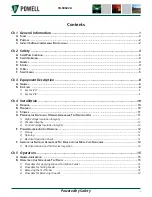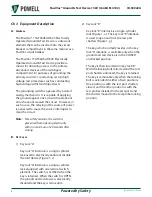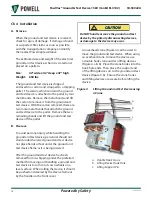
Powered by Safety
®
11
Installation
IB-50022A
C. S
TORAGE
Since the ground and test device is an
accessory device not normally in continuous
service, it is very important that it be stored
carefully so that it will be available when
needed. The following precautions must be
taken to ensure proper storage of the ground
and test device:
1. The ground and test device must not be
stored in a circuit breaker compartment.
It can only be stored in a storage
compartment.
2. The ground and test device should be
carefully protected against condensation,
preferably by storing it in a warm, dry room
of moderate temperature, such as
40° - 100°F since dampness has an adverse
affect on the insulating parts.
3. The ground and test device should be
stored in a clean location , free from
corrosive gasses or fumes. Particular care
should be taken to protect the device
from moisture and cement dust, as this
combination has a very corrosive affect on
many parts.
4. If the ground and test device is stored for
any length of time, it should be inspected
periodically for rust and to ensure it is
in good mechanical condition. Should
the ground and test device be stored
under adverse conditions, it should be
cleaned and dried before performing the
commissioning tests and before placing the
ground and test device into an energized
circuit breaker compartment.
D. P
REPARING
THE
E
LECTRICALLY
O
PERATED
G
ROUND
AND
T
EST
D
EVICE
FOR
U
SE
Before shipment from the factory, all functions
of the ground and test device are thoroughly
checked. Powell recommends that prior to
each use the ground and test device should be
thoroughly checked and the following tests be
performed in the sequence listed below:
1. High Voltage Insulation Integrity
2. Vacuum
Integrity
3. Control Voltage Insulation Integrity
4. Electrical Operation Check
1) High Voltage Insulation Integrity
The primary circuit insulation on the
ground and test device may be checked
phase-to-phase and phase-to-ground
using a 2500V insulation resistance tester.
Since definite limits cannot be given for
satisfactory insulation values when testing
with an insulation resistance tester, a record
should be kept of the insulation resistance
tester readings, as well as the temperature
and humidity readings. The records should
be used to detect any weakening of the
insulation system from one check period to
the next.
To check insulation integrity, the AC high
potential test described below is strongly
recommended.
The ground and test device insulation
should be tested with the ground and test
device vacuum interrupter contacts in
the open position. Test each pole of the
ground and test device separately with the
other two poles and the frame grounded.
Perform the field dielectric test described in
ANSI Standard C37.20.2 at the voltage level
appropriate for the equipment. This test
should check all primary phase-to-ground
and phase-to-phase insulation.













































